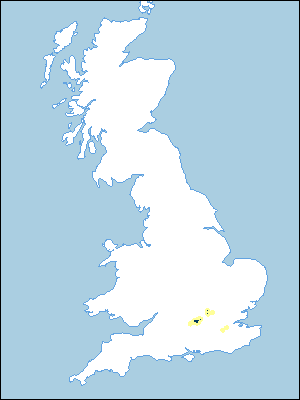
Soil Associations
0582b Hornbeam 1
Soil and site characteristics
Deep fine and coarse loamy over clayey soils with slowly permeable subsoils and slight seasonal waterlogging. Some very flinty sandy and loamy soils. Some very acid soils with bleached subsurface horizon.
Geology
Plateau and glaciofluvial drift
Cropping and Land Use
Deciduous woodland and permanent grassland; some short term grassland and cereals; gravel extraction.
Component soil series
| Subgroup | Series name | Percentage | WRB 2006 link |
|---|---|---|---|
| 5.54 | ST ALBANS | 20% | Chromic Skeletic Luvisols |
| 5.81 | MARLOW | 20% | Profundic Chromic Luvisols |
| 5.82 | HORNBEAM | 15% | Chromic Endostagnic Luvisols |
| 5.82 | BERKHAMSTED | 10% | Abruptic Chromic Endostagnic Luvisols |
| 5.81 | BOCKMER | 10% | Ruptic Chromic Skeletic Luvisols |
| 6.34 | SOUTHAMPTON | 10% | Episkeletic Ruptic Umbric Albic Podzols |
Covers 90 km2 in England and Wales
Soilscapes Classification
| 8 |
Slightly acid loamy and clayey soils with impeded drainage |
0582b Hornbeam 1
Detailed Description
Most of this association is found on the lower parts of the drift-covered Chiltern dipslope. Extending in several separate patches from north of Reading to Henley-on-Thames, Chesham, Hemel Hempstead and Berkhamsted, it includes land identified as Berkhamsted complex. It is mapped where Plateau and glaciofluvial drift (Plateau Gravel) together cap the Chalkand remnant Tertiary beds of the interfluves. Small areas have also been mapped on the North Downs near Warlingham in Surrey and Orpington in Kent on remnants of pebbly Blackheath Beds incorporated with the Plateau Drift. The land is gently or moderately sloping between 70 and 230 m O.D. There are some steep slopes on upper valley sides.
Hornbeam and Berkhamsted soils are fine and coarse loamy over clayey stagnogleyic paleo-argillic brown earths with red-mottled subsoils showing evidence of slight seasonal waterlogging. Marlow soils are fine loamy over clayey, and Bockmer soils loamy gravelly typical paleo-argillic brown earths. Both Southampton series, paleo¬argillic podzols, and St Albans series, argillic brown sands, are sandy gravelly soils.
There is little pattern to the soil distribution. Some Sonning and Batcombe soils occur locally and Hook soils are developed in small patches of aeolian silty drift near Reading. Where dry valleys have cut through the Plateau Drift into the Clay¬with-flints and the Chalk, Winchester soils are found on upper valley sides. On the North Downs, the more stony St Albans, Southampton and Bockmer soils dominate.
Soil Water Regime
Hornbeam and Berkhamsted soils have moderately permeable clayey subsoils which with appropriate drainage measures cause occasional waterlogging (Wetness Class II or III). Surface horizons readily accept winter rain, most of which passes through the clayey subsoil to underlying chalk or gravel to the water-table. In periods of heavy rainfall there may be lateral movement of water over the clayey subsoil, but such water usually reaches more permeable soils on valley sides and drains away. Marlow, Southampton, St Albans and Bockmer soils are all permeable and well drained (Wetness Class I).
Hornbeam, Berkhamsted and Marlow soils have good reserves of available water, except where the stone content is large. The soils are slightly droughty for cereals and moderately droughty for grass. In contrast, St Albans, Southampton and Bockmer soils have little available water because of coarse texture and stoniness, and are rarely used for arable crops; they are very droughty for grass.
Cropping and Land Use
Hornbeam and Berkhamsted soils are moderately easy to work but stoniness may hinder cultivations locally. Opportunities for spring cultivation are restricted especially in wet years. There are long periods in autumn and spring when Marlow soils can be cultivated though in wet springs suitable days for tillage are few. Southampton, St Albans and Bockmer soils often remain uncultivated because of stoniness and droughtiness.
The land in this heterogeneous association is used in many ways. Although woodland with some permanent grassland is common on the gravelly St Albans, Southampton and Bockmer soils, for example, north-west of Reading, the less stony soils are frequently under cultivation with cereals and ley grass the main crops. Some vegetables and fruit are grown on climatically favoured sites. There is a slight risk of poaching on Hornbeam and Berkhamsted soils but the risk is negligible on the other principal soils. Grass production is limited, however, by summer drought. All the soils are acid unless limed and levels of nutrients in St Albans and Southampton soils are generally low. Some gravel is extracted in areas of St Albans and Southampton series, and most patches of these soils remaining under woodland show signs of former small scale shallow gravel working. The Reading Beds beneath the Plateau Drift have been exploited for brickmaking at Stoke Row in Oxfordshire and at Chesham in Buckinghamshire.
A wide range of coniferous and broad-leaved species grow well in Hornbeam, Berkhamsted and Marlow soils, though acidity and nutrient deficiencies occur. Slight seasonal waterlogging in Hornbeam and Berkhamsted series gives wet ground conditions during winter months, but moisture retentive subsoils aid tree growth in summer. Corsican pine, Norway spruce, western hemlock, oak and beech are suited species. St Albans, Bockmer and Southampton are extremely stony, droughty and acid soils deficient in calcium, phosphorus and nitrogen. Rooting is restricted by gravel and subsurface pans. Tine ploughing is needed to loosen and mix subsurface horizons and ensure better rooting. The choice of suitable species is restricted to Scots or Corsican pine.
0582b Hornbeam 1
Distribution Map
 |
Note that the yellow shading represents a buffer to highlight the location of very small areas of the association.
Keys to component soil series
South Eastern Region
 |
All information Copyright, Cranfield University © 2025
Citation: To use information from this web resource in your work, please cite this as follows:
Cranfield University 2025. The Soils Guide. Available: www.landis.org.uk. Cranfield University, UK. Last accessed 25/04/2025
